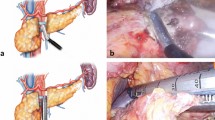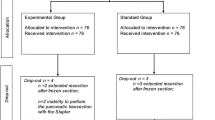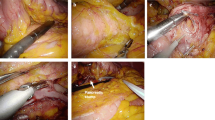Abstract
Background
Postoperative pancreatic fistula (PPF) is the most frequent and serious complication after laparoscopic distal pancreatectomy (LDP). Our goal was to compare the performance, in terms of PPF prevention, and safety of a radiofrequency (RF)-assisted transection device versus a stapler device in a porcine LDP model.
Methods
Thirty-two animals were randomly divided into two groups to perform LDP using a RF-assisted device (RF group; n = 16) and stapler device (ST group; n = 16) and necropsied 4 weeks after surgery. The primary endpoint was the incidence of PPF. Secondary endpoints were surgery/transection time, intra/postoperative complications/deaths, postoperative plasmatic amylase and glucose concentration, peritoneal liquid amylase and interleukin 6 (IL-6) concentrations, weight variations, and histopathological changes.
Results
Two clinical and one biochemical PPF were observed in the ST and RF groups respectively. Peritoneal amylase concentration was significantly higher in the RF group 4 days after surgery, but this difference was no longer present at necropsy. Both groups presented a significant decrease in peritoneal IL-6 concentration during the postoperative follow-up, with no differences between the groups. RF group animals showed a higher postoperative weight gain. In the histopathological exam, all RF group animals showed a common pattern of central coagulative necrosis of the parenchymal surface, surrounded by a thick fibrosis, which sealed main and secondary pancreatic ducts and was not found in ST group.
Conclusions
The fibrosis caused by an RF-assisted device can be at least as safe and effective as stapler compression to achieve pancreatic parenchyma sealing in a porcine LDP model.



Similar content being viewed by others
References
JH Balcom, Rattner DW, Warshaw AL, Chang Y, Fernandez-del Castillo C (2001) Ten-year experience with 733 pancreatic resections: changing indications, older patients, and decreasing length of hospitalization. Arch Surg 136:391–398
Knaebel HP, Diener MK, Wente MN, Buchler MW, Seiler CM (2005) Systematic review and meta-analysis of technique for closure of the pancreatic remnant after distal pancreatectomy. Br J Surg 92:539–546
Goh BK, Tan YM, Chung YF, Cheow PC, Ong HS, Chan WH et al (2008) Critical appraisal of 232 consecutive distal pancreatectomies with emphasis on risk factors, outcome, and management of the postoperative pancreatic fistula: a 21-year experience at a single institution. Arch Surg 143:956–965
Nathan H, Cameron JL, Goodwin CR, Seth AK, Edil BH, Wolfgang CL et al (2009) Risk factors for pancreatic leak after distal pancreatectomy. Ann Surg 250:277–281
Shrikhande SV, D’Souza MA (2008) Pancreatic fistula after pancreatectomy: evolving definitions, preventive strategies and modern management. World J Gastroenterol 14:5789–5796
Bassi C, Dervenis C, Butturini G, Fingerhut A, Yeo C, Izbicki J et al (2005) Postoperative pancreatic fistula: an international study group (ISGPF) definition. Surgery 138:8–13
Kooby DA, Chu CK (2010) Laparoscopic management of pancreatic malignancies. Surg Clin North Am 90:427–446
Kooby DA, Gillespie T, Bentrem D, Nakeeb A, Schmidt MC, Merchant NB et al (2008) Left-sided pancreatectomy: a multicenter comparison of laparoscopic and open approaches. Ann Surg 248:438–446
Fernandez-Cruz L, Cesar-Borges G, Lopez-Boado MA, Orduna D, Navarro S (2005) Minimally invasive surgery of the pancreas in progress. Langenbecks Arch Surg 390:342–354
Nigri GR, Rosman AS, Petrucciani N, Fancellu A, Pisano M, Zorcolo L et al (2011) Metaanalysis of trials comparing minimally invasive and open distal pancreatectomies. Surg Endosc 25:1642–1651
Song KB, Kim SC, Park JB, Kim YH, Jung YS, Kim MH et al (2011) Single-center experience of laparoscopic left pancreatic resection in 359 consecutive patients: changing the surgical paradigm of left pancreatic resection. Surg Endosc 25(10):3364–3372
Zhou W, Lv R, Wang X, Mou Y, Cai X, Herr I (2010) Stapler vs suture closure of pancreatic remnant after distal pancreatectomy: a meta-analysis. Am J Surg 200:529–536
Diener MK, Seiler CM, Rossion I, Kleeff J, Glanemann M, Butturini G et al (2011) Efficacy of stapler versus hand-sewn closure after distal pancreatectomy (DISPACT): a randomised, controlled multicentre trial. Lancet 377:1514–1522
Fioole B, van der Bilt JD, Elias SG, de Hoog J, Borel Rinkes IH (2005) Precoagulation minimizes blood loss during standardized hepatic resection in an experimental model. Br J Surg 92:1409–1416
Burdio F, Grande L, Berjano E, Martinez-Serrano M, Poves I, Burdio JM et al (2010) A new single-instrument technique for parenchyma division and hemostasis in liver resection: a clinical feasibility study. Am J Surg 200:e75–e80
Weber JC, Navarra G, Jiao LR, Nicholls JP, Jensen SL, Habib NA (2002) New technique for liver resection using heat coagulative necrosis. Ann Surg 236:560–563 PMCID: 1422612
Fronza JS, Bentrem DJ, Baker MS, Talamonti MS, Ujiki MB (2010) Laparoscopic distal pancreatectomy using radiofrequency energy. Am J Surg 199:401–404 (discussion 404)
Truty MJ, Sawyer MD, Que FG (2007) Decreasing pancreatic leak after distal pancreatectomy: saline-coupled radiofrequency ablation in a porcine model. J Gastrointest Surg 11:998–1007
Blansfield JA, Rapp MM, Chokshi RJ, Woll NL, Hunsinger MA, Sheldon DG et al (2012) Novel method of stump closure for distal pancreatectomy with a 75 % reduction in pancreatic fistula rate. J Gastrointest Surg 16:524–528
Dorcaratto D, Burdio F, Fondevila D, Andaluz A, Poves I, Martinez MA et al (2012) Laparoscopic distal pancreatectomy: feasibility study of radiofrequency-assisted transection in a porcine model. J Laparoendosc Adv Surg Tech A 22:242–248
Burdio F, Navarro A, Berjano E, Sousa R, Burdio JM, Guemes A et al (2008) A radiofrequency-assisted device for bloodless rapid transection of the liver: a comparative study in a pig liver model. Eur J Surg Oncol 34:599–605
Navarro A, Burdio F, Berjano EJ, Guemes A, Sousa R, Rufas M et al (2008) Laparoscopic blood-saving liver resection using a new radiofrequency-assisted device: preliminary report of an in vivo study with pig liver. Surg Endosc 22:1384–1391
Frozanpor F, Lundell L, Segersvard R, Arnelo U (2012) The effect of prophylactic transpapillary pancreatic stent insertion on clinically significant leak rate following distal pancreatectomy: results of a prospective controlled clinical trial. Ann Surg 255:1032–1036
Soper NJ, Brunt LM, Dunnegan DL, Meininger TA (1994) Laparoscopic distal pancreatectomy in the porcine model. Surg Endosc 8:57–60 (discussion 61)
Hanly EJ, Mendoza-Sagaon M, Hardacre JM, Murata K, Bunton TE, Herreman-Suquet K et al (2004) New tools for laparoscopic division of the pancreas: a comparative animal study. Surg Laparosc Endosc Percutan Tech 14:53–60
Hartwig W, Duckheim M, Strobel O, Dovzhanskiy D, Bergmann F, Hackert T et al (2010) LigaSure for pancreatic sealing during distal pancreatectomy. World J Surg 34:1066–1070
Kleeff J, Diener MK, Z’Graggen K, Hinz U, Wagner M, Bachmann J et al (2007) Distal pancreatectomy: risk factors for surgical failure in 302 consecutive cases. Ann Surg 245:573–582
Venkat R, Edil BH, Schulick RD, Lidor AO, Makary MA, Wolfgang CL (2012) Laparoscopic distal pancreatectomy is associated with significantly less overall morbidity compared to the open technique: a systematic review and meta-analysis. Ann Surg 255:1048–1059
Montorsi M, Zerbi A, Bassi C, Capussotti L, Coppola R, Sacchi M (2012) Efficacy of an absorbable fibrin sealant patch (TachoSil) after distal pancreatectomy: a multicenter, randomized, controlled trial. Ann Surg 256:853–860
Chamberlain RS, Korvick D, Mootoo M, Story S, Dubiel B, Sharpnack D (2009) Can harmonic focus curved shear effectively seal the pancreatic ducts and prevent pancreatic leak? Feasibility evaluation and testing in ex vivo and in vivo porcine models. J Surg Res 157:279–283
Chao YJ, Shan YS, Zuchini R, Tsai HW, Lin PW, Lee GB et al (2012) Successfully seal pancreatic end after thermal distal pancreatectomy using needle arrays in alternating electromagnetic fields. Surg Innov 20(2):150–157
Gehrig T, Fonouni H, Mueller-Stich BP, Golriz M, Abbassi S, Nickel F et al (2011) Comparison of different surgical techniques in distal pancreatectomy: an experimental study in a porcine model. Surg Innov 18(4):329–337
Nagakawa Y, Tsuchida A, Saito H, Tohyama Y, Matsudo T, Kawakita H et al (2008) The VIO soft-coagulation system can prevent pancreatic fistula following pancreatectomy. J Hepatobiliary Pancreat Surg 15:359–365
Suzuki Y, Fujino Y, Tanioka Y, Hori Y, Ueda T, Takeyama Y et al (1999) Randomized clinical trial of ultrasonic dissector or conventional division in distal pancreatectomy for non-fibrotic pancreas. Br J Surg 86:608–611
Geller DA, Tsung A, Maheshwari V, Rutstein LA, Fung JJ, Marsh JW (2005) Hepatic resection in 170 patients using saline-cooled radiofrequency coagulation. HPB 7:208–213 PMCID: 2023954
Kitagawa H, Ohta T, Tani T, Tajima H, Nakagawara H, Ohnishi I et al (2008) Nonclosure technique with saline-coupled bipolar electrocautery in management of the cut surface after distal pancreatectomy. J Hepatobiliary Pancreat Surg 15:377–383
Goldberg SN, Mallery S, Gazelle GS, Brugge WR (1999) EUS-guided radiofrequency ablation in the pancreas: results in a porcine model. Gastrointest Endosc 50:392–401
Hadjicostas P, Malakounides N, Varianos C, Kitiris E, Lerni F, Symeonides P (2006) Radiofrequency ablation in pancreatic cancer. HPB (Oxford) 8:61–64 PMCID: 2131369
Granger J, Remick D (2005) Acute pancreatitis: models, markers, and mediators. Shock 24(Suppl 1):45–51
Decker D, Tolba R, Springer W, Lauschke H, Hirner A, von Ruecker A (2005) Abdominal surgical interventions: local and systemic consequences for the immune system–a prospective study on elective gastrointestinal surgery. J Surg Res 126:12–18
Kylanpaa ML, Repo H, Puolakkainen PA (2010) Inflammation and immunosuppression in severe acute pancreatitis. World J Gastroenterol 16:2867–2872 PMCID: 2887581
Makhija R, Kingsnorth AN (2002) Cytokine storm in acute pancreatitis. J Hepatobiliary Pancreat Surg 9:401–410
Biffl WL, Moore EE, Moore FA, Peterson VM (1996) Interleukin-6 in the injured patient. Marker of injury or mediator of inflammation? Ann Surg 224:647–664 PMCID: 1235442
Jansson K, Redler B, Truedsson L, Magnuson A, Matthiessen P, Andersson M et al (2004) Intraperitoneal cytokine response after major surgery: higher postoperative intraperitoneal versus systemic cytokine levels suggest the gastrointestinal tract as the major source of the postoperative inflammatory reaction. Am J Surg 187:372–377
Badia JM, Whawell SA, Scott-Coombes DM, Abel PD, Williamson RC, Thompson JN (1996) Peritoneal and systemic cytokine response to laparotomy. Br J Surg 83:347–348
Baigrie RJ, Lamont PM, Kwiatkowski D, Dallman MJ, Morris PJ (1992) Systemic cytokine response after major surgery. Br J Surg 79:757–760
Acknowledgments
This work received financial support from the Spanish “Plan Nacional de I+D+I del Ministerio de Ciencia e Innovación,” Grant No. TEC2011-27133-C02-02.
Disclosures
F. Burdío, E. Bejarano, and R. Quesada declare stock ownership in Apeiron Medical S.L., a company that has a license for the patent US 8.303.584.B2, on which the device tested in this study is based. D. Dorcaratto, D. Fondevila, A. Andaluz, I. Poves, X. Mayol, M. Caceres, and L. Grande have no conflict of interests or financial ties to disclose.
Author information
Authors and Affiliations
Corresponding author
Rights and permissions
About this article
Cite this article
Dorcaratto, D., Burdío, F., Fondevila, D. et al. Radiofrequency is a secure and effective method for pancreatic transection in laparoscopic distal pancreatectomy: results of a randomized, controlled trial in an experimental model. Surg Endosc 27, 3710–3719 (2013). https://doi.org/10.1007/s00464-013-2952-1
Received:
Accepted:
Published:
Issue Date:
DOI: https://doi.org/10.1007/s00464-013-2952-1




